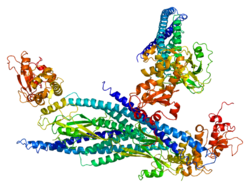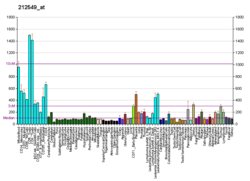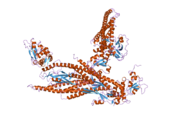Protein-coding gene in the species Homo sapiens
| STAT5B |
|---|
 |
| Identifiers |
|---|
| Aliases | STAT5B, STAT5, signal transducer and activator of transcription 5B, GHISID2 |
|---|
| External IDs | OMIM: 604260; MGI: 103035; HomoloGene: 55718; GeneCards: STAT5B; OMA:STAT5B - orthologs |
|---|
| Gene location (Human) |
|---|
 | | Chr. | Chromosome 17 (human)[1] |
|---|
| | Band | 17q21.2 | Start | 42,199,177 bp[1] |
|---|
| End | 42,276,707 bp[1] |
|---|
|
| Gene location (Mouse) |
|---|
 | | Chr. | Chromosome 11 (mouse)[2] |
|---|
| | Band | 11 D|11 63.63 cM | Start | 100,671,557 bp[2] |
|---|
| End | 100,741,550 bp[2] |
|---|
|
| RNA expression pattern |
|---|
| Bgee | | Human | Mouse (ortholog) |
|---|
| Top expressed in | - blood
- body of uterus
- left uterine tube
- right ovary
- left ovary
- paraflocculus of cerebellum
- beta cell
- frontal pole
- granulocyte
- middle frontal gyrus
|
| | Top expressed in | - medial head of gastrocnemius muscle
- triceps brachii muscle
- ankle
- muscle of thigh
- temporal muscle
- vastus lateralis muscle
- granulocyte
- thymus
- sternocleidomastoid muscle
- seminal vesicula
|
| | More reference expression data |
|
|---|
| BioGPS | 

 | | More reference expression data |
|
|---|
|
| Gene ontology |
|---|
| Molecular function | - signal transducer activity
- glucocorticoid receptor binding
- protein dimerization activity
- chromatin binding
- DNA-binding transcription factor activity
- DNA binding
- DNA-binding transcription activator activity, RNA polymerase II-specific
- protein binding
- protein tyrosine kinase activity
- RNA polymerase II cis-regulatory region sequence-specific DNA binding
- DNA-binding transcription factor activity, RNA polymerase II-specific
| | Cellular component | - nucleoplasm
- cytoplasm
- nucleus
- cytosol
| | Biological process | - positive regulation of natural killer cell differentiation
- positive regulation of natural killer cell mediated cytotoxicity
- regulation of steroid metabolic process
- creatinine metabolic process
- T cell differentiation in thymus
- female pregnancy
- cellular response to hormone stimulus
- positive regulation of activated T cell proliferation
- progesterone metabolic process
- receptor signaling pathway via JAK-STAT
- negative regulation of apoptotic process
- Peyer's patch development
- transcription, DNA-templated
- signal transduction
- cellular response to growth factor stimulus
- natural killer cell differentiation
- response to interleukin-4
- sex differentiation
- valine metabolic process
- positive regulation of B cell differentiation
- T cell homeostasis
- creatine metabolic process
- cellular response to epidermal growth factor stimulus
- response to estradiol
- positive regulation of inflammatory response
- regulation of transcription by RNA polymerase II
- mast cell migration
- positive regulation of mitotic cell cycle
- lipid storage
- development of secondary female sexual characteristics
- fatty acid metabolic process
- taurine metabolic process
- succinate metabolic process
- positive regulation of gamma-delta T cell differentiation
- positive regulation of lymphocyte differentiation
- regulation of multicellular organism growth
- citrate metabolic process
- positive regulation of cell population proliferation
- oxaloacetate metabolic process
- regulation of epithelial cell differentiation
- positive regulation of natural killer cell proliferation
- development of secondary male sexual characteristics
- positive regulation of multicellular organism growth
- regulation of transcription, DNA-templated
- allantoin metabolic process
- positive regulation of transcription by RNA polymerase II
- transcription by RNA polymerase II
- luteinization
- isoleucine metabolic process
- negative regulation of erythrocyte differentiation
- lactation
- response to interleukin-15
- regulation of cell adhesion
- 2-oxoglutarate metabolic process
- response to interleukin-2
- growth hormone receptor signaling pathway via JAK-STAT
- positive regulation of erythrocyte differentiation
- peptidyl-tyrosine phosphorylation
- interleukin-7-mediated signaling pathway
- interleukin-15-mediated signaling pathway
- cytokine-mediated signaling pathway
- interleukin-2-mediated signaling pathway
- interleukin-9-mediated signaling pathway
- defense response
- regulation of cell population proliferation
- response to peptide hormone
| | Sources:Amigo / QuickGO |
|
| Orthologs |
|---|
| Species | Human | Mouse |
|---|
| Entrez | | |
|---|
| Ensembl | | |
|---|
| UniProt | | |
|---|
| RefSeq (mRNA) | | |
|---|
NM_001113563
NM_011489
NM_001362682 |
|
|---|
| RefSeq (protein) | | |
|---|
NP_001107035
NP_035619
NP_001349611 |
|
|---|
| Location (UCSC) | Chr 17: 42.2 – 42.28 Mb | Chr 11: 100.67 – 100.74 Mb |
|---|
| PubMed search | [3] | [4] |
|---|
|
| Wikidata |
| View/Edit Human | View/Edit Mouse |
|
Signal transducer and activator of transcription 5B is a protein that in humans is encoded by the STAT5B gene.[5] STAT5B orthologs[6] have been identified in most placentals for which complete genome data are available.
Function
The protein encoded by this gene is a member of the STAT family of transcription factors. In response to cytokines and growth factors, STAT family members are phosphorylated by the receptor associated kinases, and then form homo- or heterodimers that translocate to the cell nucleus where they act as transcription activators. This protein mediates the signal transduction triggered by various cell ligands, such as IL2, IL4, CSF1, and different growth hormones. It has been shown to be involved in diverse biological processes, such as TCR signaling, apoptosis, adult mammary gland development, and sexual dimorphism of liver gene expression. This gene was found to fuse to retinoic acid receptor-alpha (RARA) gene in a small subset of acute promyelocytic leukemias (APML). The dysregulation of the signaling pathways mediated by this protein may be the cause of the APML.[7]
Interactions
STAT5B has been shown to interact with:
See also
References
- ^ a b c GRCh38: Ensembl release 89: ENSG00000173757 – Ensembl, May 2017
- ^ a b c GRCm38: Ensembl release 89: ENSMUSG00000020919 – Ensembl, May 2017
- ^ "Human PubMed Reference:". National Center for Biotechnology Information, U.S. National Library of Medicine.
- ^ "Mouse PubMed Reference:". National Center for Biotechnology Information, U.S. National Library of Medicine.
- ^ Lin JX, Mietz J, Modi WS, John S, Leonard WJ (July 1996). "Cloning of human Stat5B. Reconstitution of interleukin-2-induced Stat5A and Stat5B DNA binding activity in COS-7 cells". J. Biol. Chem. 271 (18): 10738–44. doi:10.1074/jbc.271.18.10738. PMID 8631883.
- ^ "OrthoMaM phylogenetic marker: STAT5B coding sequence". Archived from the original on 2015-09-24. Retrieved 2010-02-17.
- ^ "Entrez Gene: STAT5B signal transducer and activator of transcription 5B".
- ^ Stöcklin E, Wissler M, Gouilleux F, Groner B (October 1996). "Functional interactions between Stat5 and the glucocorticoid receptor" (PDF). Nature. 383 (6602): 726–8. Bibcode:1996Natur.383..726S. doi:10.1038/383726a0. PMID 8878484. S2CID 4356272.
- ^ a b Fujitani Y, Hibi M, Fukada T, Takahashi-Tezuka M, Yoshida H, Yamaguchi T, Sugiyama K, Yamanaka Y, Nakajima K, Hirano T (February 1997). "An alternative pathway for STAT activation that is mediated by the direct interaction between JAK and STAT". Oncogene. 14 (7): 751–61. doi:10.1038/sj.onc.1200907. PMID 9047382. S2CID 20789082.
- ^ Barahmand-Pour F, Meinke A, Groner B, Decker T (May 1998). "Jak2-Stat5 interactions analyzed in yeast". J. Biol. Chem. 273 (20): 12567–75. doi:10.1074/jbc.273.20.12567. PMID 9575217.
- ^ Yu CL, Jin YJ, Burakoff SJ (January 2000). "Cytosolic tyrosine dephosphorylation of STAT5. Potential role of SHP-2 in STAT5 regulation". J. Biol. Chem. 275 (1): 599–604. doi:10.1074/jbc.275.1.599. PMID 10617656.
Further reading
- Kisseleva T, Bhattacharya S, Braunstein J, Schindler CW (2002). "Signaling through the JAK/STAT pathway, recent advances and future challenges". Gene. 285 (1–2): 1–24. doi:10.1016/S0378-1119(02)00398-0. PMID 12039028.
|
|---|
| Chemokine | |
|---|
| CSF | |
|---|
| Interferon | | IFNAR (α/β, I) | - Agonists: Albinterferon
- Interferon alpha (interferon alfa, IFN-α)
- Interferon alfa (IFNA1, IFNA2, IFNA4, IFNA5, IFNA6, IFNA7, IFNA8, IFNA10, IFNA13, IFNA14, IFNA16, IFNA17, IFNA21)
- Interferon alfa 2a
- Interferon alfa 2b
- Interferon alfa n1
- Interferon alfacon-1
- Interferon alpha-n3
- Interferon beta (IFN-β) (IFNB1, IFNB3)
- Interferon beta 1a
- Interferon beta 1b
- Interferon kappa (IFN-ε/κ/τ/ζ, IFNK)
- Interferon omega (IFN-ω, IFNW1)
- Peginterferon alfa-2a
- Peginterferon alfa-2b
- Decoy receptors: Bifarcept
|
|---|
| IFNGR (γ, II) | |
|---|
| IFNLR (λ, III) | - See IL-28R (IFNLR) here instead.
|
|---|
|
|---|
| Interleukin | |
|---|
| TGFβ | |
|---|
| TNF | |
|---|
| Others | |
|---|
This article incorporates text from the United States National Library of Medicine, which is in the public domain.
 | This article on a gene on human chromosome 17 is a stub. You can help Wikipedia by expanding it. |

 1y1u: Structure of unphosphorylated STAT5a
1y1u: Structure of unphosphorylated STAT5a





















